|
|
LRTC Emergency Response Team
TECHNICAL INFORMATION
Developing an Effective Regional
Large Animal Evacuation Program
|
Part Six
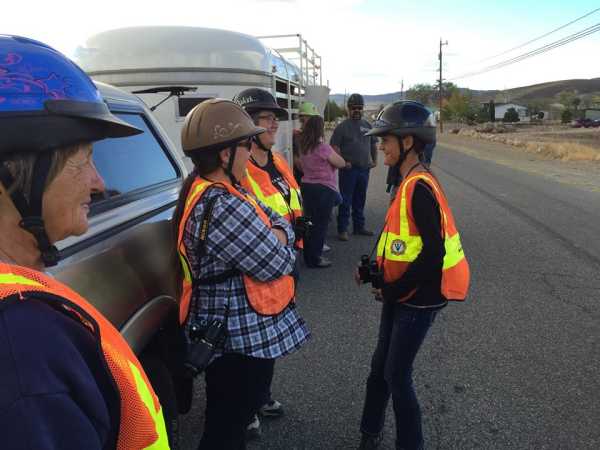
|
|
Issues Involved With Responses
|
This feature is a continuation of Part Five.
One important element to consider in developing a relationship with professional emergency agencies involves an understanding as to how volunteers are expected to operate. Having a plethora of volunteers show up and operate helter skelter is not something that managers of complex and challenging incidents want to add to their scope of responsibilities. Understanding how volunteers can best fit into an incident command system and being able to articulate that understanding to emergency officials is often a critical selling point.
Remember, in emergencies there has to be some formal structure where everyone is answerable to a specific superior and everyone operating at the incident is properly accounted for. Additionally, supervisors can't have more subordinates than they can safely and effectively supervise. Therefore the arrival of a collection of "random" volunteer resources often cannot be accommodated unless incident personnel are reassigned to supervise them.
The following are some key definitions, followed by a practical application of those definitions that would be relevant to organizing effective animal evacuation operations.
- Chain of Command. A specific and often predesignated hierarchy of authority.
- Unity of Command. Everyone is answerable to one designated superior until formally told otherwise. (Nobody has multiple bosses giving conflicting orders.)
- Span of Control. Every supervisor should not have more than five subordinates to supervise.
- Division. A fixed physical area of an incident such as an operational portion of the perimeter of a large fire, typically designated by a letter with letters typically increasing in a clockwise direction (e.g., Division A, Division H, etc.) Resources assigned to a division only operate within the physical boundaries of that division.
- Group. A collection of resources assembled for a specific purpose that could be deployed anywhere in the incident, not limited to a specific geographic division. Examples could include Structure Protection Group, Rescue Group, Animal Rescue Group.
- Division Supervisor / Group Supervisor. The designated person in charge of resources operating in a specific Division or Group.
- Single Resource. A single unit (fire engine, rescue team, evac team, etc.)
- Strike Team. 3 to 5 similar units with a designated leader and common communications. (A strike team could consist of five evac stock trailers and a leader.)
- Task Force. 3 to 5 diverse units with a leader and common communications. (A task force could consist of two animal control kennel trucks and three evac stock trailers with a leader.)
- Safety Officer. A person at an incident or an operational area who is responsible for operational safety and whose word in safety matters is law.
- Spontaneous Volunteer. Someone who shows up at an incident who is willing to help, but who was not requested and whose credentials and qualifications may not be known.
- Personnel Accountability Report (or "PAR"). A practice that ensures that everyone functioning in the operational area is periodically accounted for.
- Staging Area (or "Staging"). A designated location where responding resources assemble and stand-by at the ready for assignments.
- Demobilization. The official process in which resources are dismissed from (leave) an incident whereupon Incident Command becomes formally aware that such resources are no longer involved in the incident and are no longer Incident Command's responsibility.
HOW THESE ELEMENTS IMPACT ANIMAL RESCUE
From the rescuers' viewpoint, a situation has occurred where large animals are at risk and need to be relocated to safety. Typically the rescuers are driven by empathy having large animals themselves, coupled with an understanding as to the animals' economic and emotional values to their owners.
From the incident commanders' viewpoint, while understanding the value of removing animals from danger, the first priority is human life safety. With the perceived infusion of multiple resources that may not be adequately prepared, equipped and/or supervised, human life safety concerns trump those of animal safety.
From law enforcement's viewpoint, additional citizens in an evacuated and controlled area create increased difficulty in determining who is roaming about for legitimate purposes and who might be utilizing the emergency to commit thefts and burglaries.
For these and other reasons, incident commanders and law enforcement may be reluctant to admit volunteer rescuers into an emergency zone unless they are recognized as being part of an approved plan. For these and other reasons, authorized trained volunteers should carry team identity cards and wear appropriate responder attire to expedite clearance for access when deployed into an emergency zone. If available, providing a marked law enforcement unit or Search and Rescue escort can expedite both travel and access, as well as provide a measure of security at the various evacuation sites.
Here are some examples as to how effective responses may be organized and how they can fit into an overall incident plan.
- Strike Teams and Task Forces
Organizing responses into ICS compliant strike teams or task forces addresses a number of issues. (For simplicity, "strike team" is used to describe both strike teams and task forces.)
One person, the Strike Team Leader, is in charge of the assemblage. Therefore whomever is supervising this area of operations at the incident only has a span of control increase of one (the Strike Team Leader,) not several individuals. Chain of command and unity of command can be maintained without degrading span of control.
The Strike Team Leader is responsible for supervising each unit in the team.
The Strike Team Leader is responsible for designating someone as the team's Safety Officer and maintaining PAR.
A strike team enters the incident as one functioning element, and leaves the incident as one functioning element, simplifying resource accountability.
Assets within the strike team may be assigned out for specific missions but the strike team will remain a coherent combined unit within the incident's organizational structure unless individual crews are formally assigned to other functions and other supervisors.
A strike team of five stock trailers with a Strike Team Leader lined up
for assignment at the Little Valley Fire. The Strike Team Leader had direct VHF
radio contact with his supervisor. The units communicated with each other via CB.
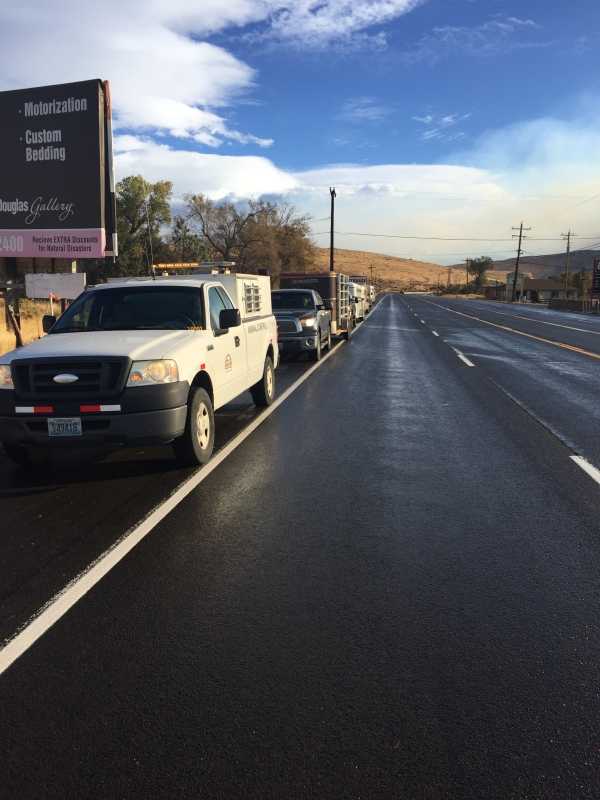
A task force of animal control vehicles and stock trailers with
a Task Force Supervisor staged at the Rolling Hills Fire.
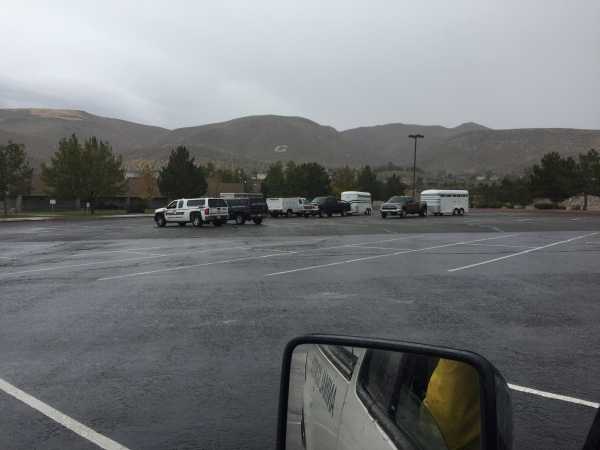
When multiple strike teams, task forces and/or single resources are operating, animal evacuation volunteers should be prepared to organize into an Animal Rescue Group.
The Animal Rescue Group Supervisor would then be responsible to the incident's Operations Section Chief or the Chief's designated subordinate, whereupon the Group Supervisor would be responsible for organizing and supervising strike teams, task forces and/or single resources assembled to perform large animal rescue functions.
The ARG Supervisor would be responsible for managing animal related resources and teams.
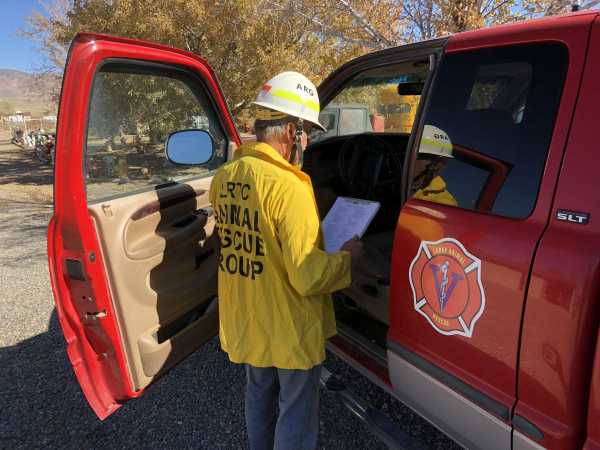
The Animal Rescue Group Supervisor could also be responsible for cataloguing spontaneous volunteers and integrating them into the group's response plan where appropriate. (Large animal owners tend to have some understanding as to the abilities of other large animal owners as well as the capabilities of their equipment.)
Some members of the Animal Rescue Group taking
a break while in the staging area, Bison fire.
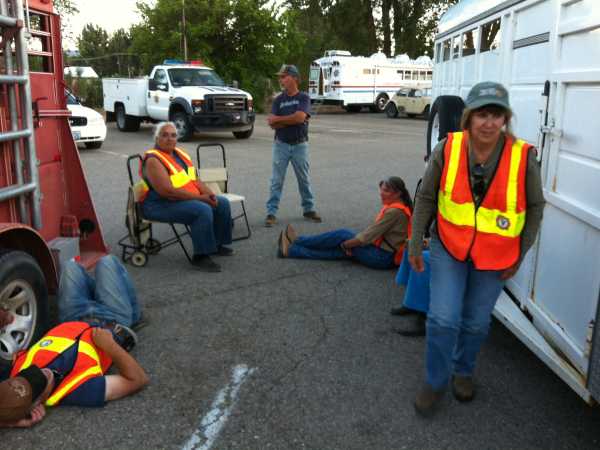
The Strike Team Leader or Group Supervisor is ultimately responsible for providing for logistic support (food, hydration, etc.) for the responders in his/her team or group. Logistic support may be accomplished by making requests through Incident Command or the team or group may have to fend for itself.
Regardless as to how such issues are addressed, the Leader or Supervisor should be aware of pending needs and make plans to accommodate them. Appropriate personal and team attire and gear can help mitigate problems associated with incident logistics personnel recognizing and supporting the needs of formally deployed volunteers.
Specialized resources such as panels or clean water for stock when power is cut that supplies wells
need to be planned for and ordered up in time to be utilized when needed. (Note the foam spilled
over from fire units that filled previously. Water from fire apparatus is not suitable for livestock.)
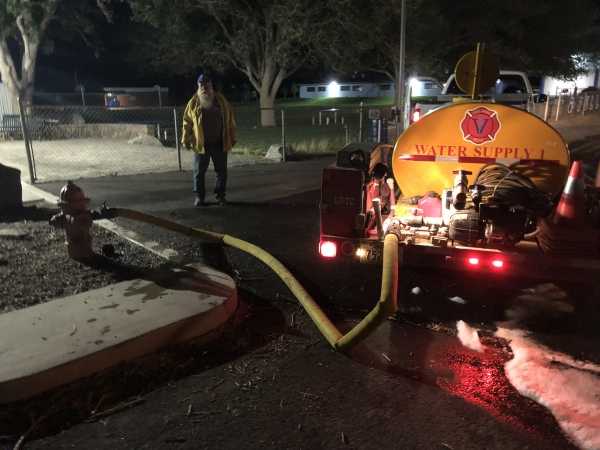
Rehab is also an issue that must be considered when volunteers are exposed long term to excessive heat or cold. These are issues that can often be best coordinated with regular emergency services agencies.
After working in high water, getting shelter and hot beverages from Squad 36. (Dayton Valley flood)
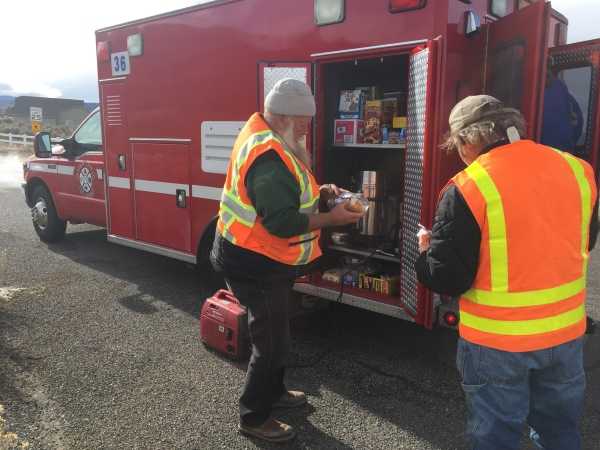
Regardless as to how such issues are addressed, the Leader or Supervisor should be aware of pending needs and make plans to accommodate them or delegate such duties to the appropriate Safety Officer.
Newly developing trained volunteer programs intended to perform large animal evacuations and operate shelters may not include personnel with the training, skills and experience to perform more than basic functions. Thus they may require greater supervision by incident management, perhaps by delegating such responsibilities to personnel having the required specialized skills until the designated volunteers achieve more training and experience working in a disaster environment. The operational area's Emergency Plan may include the development and inclusion of appropriately qualified supervision and management personnel, preferably with adequate knowledge of horses and livestock, for deployment during incidents.
To become an effectively utilized local asset, at least one representative of the animal evacuation and shelter trained volunteer group should be invited to participate in emergency planning meetings. That presence would help get the group included in joint training exercises and encourage access to other training opportunities. Discussions would help identify how such local assets could also be used for incidents not specific to animal evacuation or sheltering, which would expand the value of those assets.
For example, the trained volunteers may be useful in logistics using trucks, and perhaps trailers, for many other types of incidents. Trucks can deliver supplies or transport equipment during a health or other emergency. Four Wheel Drive vehicles can access where others can't. For example, during the 2017 northern Nevada floods, animal evac team volunteers were assigned sectors to patrol and they monitored water and road impacts when not engaged in animal removals.
Trucks (and trailers as needed) can be utilized during Search and Rescue responses as transportation support into the field to drop off and pick up search personnel (and possibly transport their search horses or search dogs) to allow more versatility for search assignments having multiple start and end points. Trained evac volunteers could meet teams in the field to deliver supplies like meals and water. The group could be more effective by being established within the local response system, equipped with communications, understanding how to work within ICS structure, etc.
Determining how many functions that local trained volunteer resources can be utilized is advantageous. Utilizing those trained volunteers will also help keep them engaged, reduce spontaneous freelance activities, and help retain members.
HOW UNDERSTANDING THESE ELEMENTS CAN
AFFECT COOPERATION FROM PUBLIC AGENCIES
Too many would-be animal rescuers are interested in turning out to help in emergencies but they don't have an interest in participating in training that would make them viable resources at an incident. In many circumstances such training is not even readily available. Therefore these spontaneous volunteers are often viewed by those commanding an already chaotic event as additional distractions rather than useful resources.
Providing task-specific basic training and being selective about assigning suitable tasks can make spontaneous volunteers very useful, freeing up emergency personnel for other tasks. During the early stages when a major incident is unfolding, some basic training for specific tasks could be rapidly provided and documented during the initial briefing process.
Understanding and being able to articulate some basic understanding as to how major emergencies are managed, the various issues involved with respect to being utilized as volunteers, and providing a draft plan as to how the animal welfare camp can effectively address these issues, a practical foundation can often be created for developing an effective response system.
© 2017 Least Resistance Training Concepts. All rights reserved.
Permission to use content and images for non-commercial purposes.
| 








